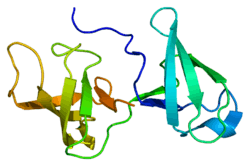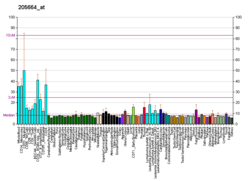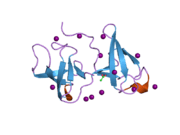KIN (gene)
DNA/RNA-binding protein KIN17 is a protein that in humans is encoded by the KIN gene.[5][6]
The protein encoded by this gene is a nuclear protein that forms intranuclear foci during proliferation and is redistributed in the nucleoplasm during the cell cycle. Short-wave ultraviolet light provokes the relocalization of the protein, suggesting its participation in the cellular response to DNA damage. Originally selected based on protein-binding with RecA antibodies, the mouse protein presents a limited similarity with a functional domain of the bacterial RecA protein, a characteristic shared by this human ortholog.[6]
References
- 1 2 3 GRCh38: Ensembl release 89: ENSG00000151657 - Ensembl, May 2017
- 1 2 3 GRCm38: Ensembl release 89: ENSMUSG00000037262 - Ensembl, May 2017
- ↑ "Human PubMed Reference:".
- ↑ "Mouse PubMed Reference:".
- ↑ Angulo JF, Rouer E, Mazin A, Mattei MG, Tissier A, Horellou P, Benarous R, Devoret R (Nov 1991). "Identification and expression of the cDNA of KIN17, a zinc-finger gene located on mouse chromosome 2, encoding a new DNA-binding protein". Nucleic Acids Res. 19 (19): 5117–23. doi:10.1093/nar/19.19.5117. PMC 328864. PMID 1923796.
- 1 2 "Entrez Gene: KIN KIN, antigenic determinant of recA protein homolog (mouse)".
Further reading
- Biard DS, Saintigny Y, Maratrat M, et al. (1997). "Differential expression of the HsKin17 protein during differentiation of in vitro reconstructed human skin". Arch. Dermatol. Res. 289 (8): 448–56. doi:10.1007/s004030050220. PMID 9266022.
- Kannouche P, Angulo JF (1999). "Overexpression of kin17 protein disrupts nuclear morphology and inhibits the growth of mammalian cells". J. Cell Sci. 112 (19): 3215–24. PMID 10504327.
- Blattner C, Kannouche P, Litfin M, et al. (2000). "UV-Induced stabilization of c-fos and other short-lived mRNAs". Mol. Cell. Biol. 20 (10): 3616–25. doi:10.1128/MCB.20.10.3616-3625.2000. PMC 85654. PMID 10779351.
- Kannouche P, Mauffrey P, Pinon-Lataillade G, et al. (2000). "Molecular cloning and characterization of the human KIN17 cDNA encoding a component of the UVC response that is conserved among metazoans". Carcinogenesis. 21 (9): 1701–10. doi:10.1093/carcin/21.9.1701. PMID 10964102.
- Biard DS, Miccoli L, Despras E, et al. (2002). "Ionizing radiation triggers chromatin-bound kin17 complex formation in human cells". J. Biol. Chem. 277 (21): 19156–65. doi:10.1074/jbc.M200321200. PMID 11880372.
- Miccoli L, Biard DS, Créminon C, Angulo JF (2002). "Human kin17 protein directly interacts with the simian virus 40 large T antigen and inhibits DNA replication". Cancer Res. 62 (19): 5425–35. PMID 12359749.
- Strausberg RL, Feingold EA, Grouse LH, et al. (2003). "Generation and initial analysis of more than 15,000 full-length human and mouse cDNA sequences". Proc. Natl. Acad. Sci. U.S.A. 99 (26): 16899–903. doi:10.1073/pnas.242603899. PMC 139241. PMID 12477932.
- Masson C, Menaa F, Pinon-Lataillade G, et al. (2003). "Global genome repair is required to activate KIN17, a UVC-responsive gene involved in DNA replication". Proc. Natl. Acad. Sci. U.S.A. 100 (2): 616–21. doi:10.1073/pnas.0236176100. PMC 141045. PMID 12525703.
- Despras E, Miccoli L, Créminon C, et al. (2003). "Depletion of KIN17, a human DNA replication protein, increases the radiosensitivity of RKO cells". Radiat. Res. 159 (6): 748–58. doi:10.1667/0033-7587(2003)159[0748:DOKAHD]2.0.CO;2. ISSN 0033-7587. PMID 12751957.
- Biard DS, Miccoli L, Despras E, et al. (2004). "Participation of kin17 protein in replication factories and in other DNA transactions mediated by high molecular weight nuclear complexes". Mol. Cancer Res. 1 (7): 519–31. PMID 12754299.
- Miccoli L, Biard DS, Frouin I, et al. (2003). "Selective interactions of human kin17 and RPA proteins with chromatin and the nuclear matrix in a DNA damage- and cell cycle-regulated manner". Nucleic Acids Res. 31 (14): 4162–75. doi:10.1093/nar/gkg459. PMC 165974. PMID 12853634.
- Andersen JS, Lam YW, Leung AK, et al. (2005). "Nucleolar proteome dynamics". Nature. 433 (7021): 77–83. doi:10.1038/nature03207. PMID 15635413.
- Miccoli L, Frouin I, Novac O, et al. (2005). "The human stress-activated protein kin17 belongs to the multiprotein DNA replication complex and associates in vivo with mammalian replication origins". Mol. Cell. Biol. 25 (9): 3814–30. doi:10.1128/MCB.25.9.3814-3830.2005. PMC 1084281. PMID 15831485.
- le Maire A, Schiltz M, Braud S, et al. (2006). "Crystallization and halide phasing of the C-terminal domain of human KIN17". Acta Crystallographica Section F. 62 (Pt 3): 245–8. doi:10.1107/S174430910600409X. PMC 2197188. PMID 16511313.
- le Maire A, Schiltz M, Stura EA, et al. (2007). "A tandem of SH3-like domains participates in RNA binding in KIN17, a human protein activated in response to genotoxics". J. Mol. Biol. 364 (4): 764–76. doi:10.1016/j.jmb.2006.09.033. PMID 17045609.
This article is issued from
Wikipedia.
The text is licensed under Creative Commons - Attribution - Sharealike.
Additional terms may apply for the media files.






